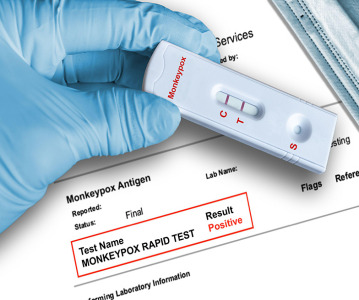Aquarium-to-bedside drug shows promise in small pediatric trial

NIH-funded research suggests zebrafish models may be efficient resource for identifying drugs for clinical use.
“Bench-to-bedside” describes research that has progressed from basic science in animal models that has led to therapies used in patients. Now, a study in the journal Brain describes what could be considered a direct “aquarium-to-bedside” approach, taking a drug discovered in a genetic zebrafish model of epilepsy and testing it, with promising results, in a small number of children with the disease. The study was supported by the National Institute of Neurological Disorders and Stroke (NINDS), part of the National Institutes of Health.
“This is the first time that scientists have taken a potential therapy discovered in a fish model directly into people in a clinical trial,” said Vicky Whittemore, program director at the NINDS. “These findings suggest that it may be possible to treat neurological disorders caused by genetic mutations through an efficient and precision medicine-style approach.”
Scott C. Baraban, the William K. Bowes Jr. Endowed Chair in Neuroscience Research and professor of neurological surgery at the University of California, San Francisco (UCSF), postdoctoral fellow Aliesha Griffin, and colleagues used a zebrafish model of Dravet syndrome to test the drug lorcaserin and found that it suppressed seizure activity in the fish. Dravet syndrome is a severe form of pediatric epilepsy characterized by frequent daily drug-resistant seizures and developmental delays. It is caused by a genetic mutation, which Dr Baraban’s group was able to introduce into the zebrafish to cause epilepsy.
Dr Baraban and his colleague Kelly Knupp, MD at the University of Colorado, Denver, then tested lorcaserin in five children with Dravet syndrome. The children were resistant to other anti-epileptic drugs and participated in this study through a compassionate use, off-label program. Lorcaserin was initially associated with decreased seizure frequency in all of the children. For example, during the first 3 months of treatment, one of the patients who had been experiencing multiple seizures every day, became seizure-free for 2 weeks. After 3 months, however, seizure activity had increased, but the frequency was less than had been reported at the start of the trial. None of the children experienced severe side effects, although some reported a decreased appetite.
This builds on work from a 2013 study in which Dr Baraban and his team at UCSF used an automated drug screening method to identify potential anti-epileptic therapies and discovered that the compound clemizole decreased seizure activity in the zebrafish.
In the current study, Dr Baraban’s team discovered that clemizole may have its anti-seizure effects by acting on the serotonin system. The researchers next identified a comparable drug, lorcaserin, which also affects the serotonin system and is available for clinical use.
“Using zebrafish, we can greatly reduce the time between identification of a potential treatment and getting it to individuals who desperately need help,” said Dr Baraban.
Dr Baraban’s group is currently developing clemizole and its derivatives, for use in clinical trials. In addition, the researchers at UCSF are conducting experiments to learn more about the role of specific serotonin receptors in epilepsy in hopes of generating more effective treatments for children suffering from Dravet syndrome.
Related News
-
News CPHI Frankfurt 2022: Innovator Interview – DSM Biomedical
At CPHI Frankfurt we spoke to Anne-Cecile Bayne, Global Science & Innovation Lead Pharma and Medical Nutrition, and Marc Hendriks, Vice President Strategy & Business Development, on their expertise in nitrosamines and business strategy at DSM Biomedica... -
News New WHO health emergency guidelines expect full transparency from Big Pharma
The WHO are proposing a new set of pandemic guidelines to set out how future global health crises should be handled. -
News Magic mushrooms could be used to treat mental health conditions
A compound found in magic mushrooms, psilocybin, could be used to treat mental health conditions and help patients suffering with severe depression, as shown by the results of the largest study of its kind to date. -
News UK-based partnership to launch DETERMINE study into rare cancer research
UK-based CRO Quanticate is set to partner with Cancer Research UK for the launch of the DETERMINE study focused on testing a range of existing and approved drugs and therapies on rare cancers. -
News FDA approves Thermo Fisher blood tests for wheat and sesame allergies
Both tests have been approved by the US regulator for in vitro diagnostic use -
News QIAGEN launches world’s first syndromic test for monkeypox
The test can distinguish between monkeypox and other diseases that cause similar symptoms. -
News Monkeypox Update: Vaccine shortage, sewage surveillance and global testing
As concern over the monkeypox outbreak continues to rise, we take a look at major developments from the first week of August. -
News CPHI Podcast Series: The importance of novel excipients for innovative drug development
The latest episode in the CPHI Podcast Series dives into the world of novel excipients and explores their importance for innovative drug development.
Position your company at the heart of the global Pharma industry with a CPHI Online membership
-
Your products and solutions visible to thousands of visitors within the largest Pharma marketplace
-
Generate high-quality, engaged leads for your business, all year round
-
Promote your business as the industry’s thought-leader by hosting your reports, brochures and videos within your profile
-
Your company’s profile boosted at all participating CPHI events
-
An easy-to-use platform with a detailed dashboard showing your leads and performance


.png)




